Top News
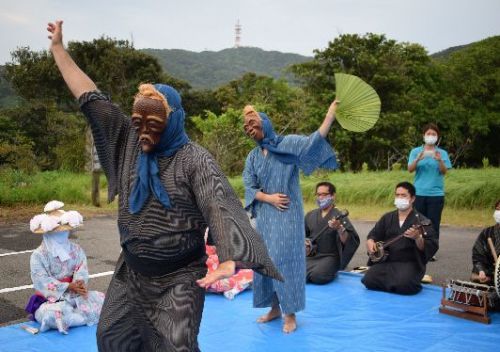
September 2, 2020 Ryukyu Shimpo
Ishigaki – The Ishigaki Ishanagira Youth Association performed the Yaeyama traditional ceremony angama in Fukuyamada, Azaishigaki, which was an evacuation site for Azaishigaki residents during the way, on September 1, the middle of Bon on the lunar calendar. Due to the ongoing coronavirus pandemic, the event was scaled down and went without the well-known humorous Sumamuni (Yaeyama language) question-and-answer exchange. They honored ancestors who died from malaria during the Pacific War, marking 75 years since the end of the fighting.
In the performance, Ushumai (an old man) and Nmi (an old woman) arrive from Guso (the afterlife) accompanied by three fama (children). Ushumai said a resolution about passing down a peaceful word, saying, “There is malaria in a war-torn world. Now, you face the coronavirus, and I pray that this too can be subdued,” offering incense. Normally for angama¸ the event travels from house to house in the village, delighting the residents they visit. Due to concerns about the coronavirus, the event sought to limit the “Three C’s” (closed spaces with poor ventilation, crowded areas and close-contact settings), and the area largely refrained from participating.
(English translation by T&CT and Sam Grieb)
Go to Japanese

August 25, 2020 Ryukyu Shimpo
Hiroshi Miyata, research fellow at Okinawa University and Okinawa International University, has been analyzing the Okinawa Defense Bureau’s (ODB) construction costs, noting that around half of their construction orders were placed with companies outside of Okinawa, and has concluded that between 2014 and 2019 the economic ripple effect amounted to losses of around 324.8 billion yen, and over 23,000 jobs. Miyata indicates, “If the entirety of the expenditures had flowed through Okinawa, it should have created around that amount of economic benefit.”
Miyata based his calculations on an itemized list of expenditures both within and outside of Okinawa prefecture for the initial contract amount, as provided to the Ryukyu Shimpo by the ODB. The money for base construction has been identified as “mainland reflux,” an economic structure where the funds flow out of the prefecture to large firms. Miyata says, “There is a fundamental problem when public works funds related to the base are not circulated within the prefecture. The burden of the bases is born by Okinawa, but the profits are enjoyed by the mainland.”
(English translation by T&CT and Sam Grieb)
Go to Japanese
September 1, 2020 Ryukyu Shimpo
Due to the impacts of the novel coronavirus pandemic, the Okinawan government has proposed before August 31 to delay the 7th Worldwide Uchinanchu Festival by a full year. The festival was originally scheduled for October 2021. The prefecture contacted the approximately 140 groups comprising the executive committee by mail. An official decision will be made in September after deliberations.
The prefecture judged it would be difficult for festival-goers to travel for the event, as the coronavirus pandemic shows no signs of subsiding and countries across the world have imposed travel restrictions. Under the circumstances, it concluded that this year’s festival will unlikely meet the objective of “expanding and developing the uchina network through exchanges with uchinanchu in Okinawa and passing it on to the next generation,” and therefore called for a postponement.
A representative from the prefectural government set up a web conference with uchinanchus abroad and communicated, “By the end of the fiscal year, I would like to discuss the challenges we faced with the previous festival, and establish what we want to accomplish in the next one.”
The previous festival in Okinawa welcomed approximately 8,000 visitors from 27 countries. Of the 8,000 visitors, approximately 1,800 were from Hawaii. President Lynn Miyahira of the Hawaii United Okinawa Association commented, “Major events have been canceled all over the world, so I am not surprised by the postponement.” She added, “I look forward to reuniting with the people in Okinawa and other uchinanchus from around the world soon.”
This year, the Hawaii United Okinawa Association will be holding its annual Okinawan Festival online, due to the pandemic. The event will start at noon on September 5 Japan time and will feature song and dance performances. Miyahira is hoping to see viewers “from all over the world.” Visit the Okinawan Festival website to find out more and join.
(English translation by T&CT and Monica Shingaki)
Go to Japanese

August 27, 2020 Ryukyu Shimpo online edition
On August 27 in the Naha District Court (Judge Kaoru Hirayama presiding), a decision was handed down in the public trial of the lawsuit requesting that the city shoulder the responsibility of conducting a local referendum concerning the plan to deploy Ground Self-Defense Forces to Hirae-Omata, Ishigaki City. Judge Hirayama rejected all of the plaintiffs’ claims as illegitimate. This is the first time that a judicial ruling has been handed down concerning the responsibility of conducting a referendum.
In this decision, it was judged that conducting a referendum is not an action that can be subject to a lawsuit based on the Administrative Case Litigation Act. The plaintiffs’ lawsuit was essentially turned away at the door, and dismissed without deliberation on the content of the claims since conducting a referendum not being allowed as the subject of the lawsuit.
This lawsuit was filed in September last year by Ishigaki City residents. Under the provisions of self-government basic regulations, residents can request a referendum with enough signatures from constituents. The residents claimed that not conducting a referendum would be a failure to act and therefore a violation of the regulations. Residents asked the court to confirm that a failure of Ishigaki City to act would be unlawful, and for the city to shoulder the responsibility of the referendum.
In November 2018 the Association for Requesting an Ishigaki City Referendum, which was organized by young people living in Ishigaki City, started a signature-collecting campaign that collected signatures in favor of holding a referendum. The campaign collected 14,263 signatures, which accounts for more than one-third of constituents in Ishigaki City. In response to the residents’ request, the city submitted a public referendum ordinance proposal to the city assembly in December of the same year. However, in February 2019 the proposal was voted down.
(English translation by T&CT and Erin Jones)
Go to Japanese
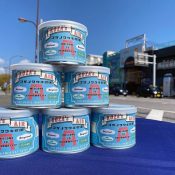
August 27, 2020 Ryukyu Shimpo
By Hikaru Masaki
Okinawa – The air of Koza in a can! Following the example of canned air from certain regions or eras sold throughout Japan, the Okinawa City Tourism & Products Association (OCTPA) began selling Koza’s Air: Gate Street Edition on August 21. OCTPA spent around 2 months commercializing the canned air.
Kazusei Yamada, head of the association, explained the reason for developing the product. “There’s so little fun in the news these days. We wanted to make people laugh with a humorous product. It’s difficult to travel right now, so our hope is that someone who buys this canned air will remember Okinawa City and come visit again.”
Yasutaka Hanashiro is in charge of products for OCTPA and came up with the packaging and the items to be included in the can. He incorporated the American feel of Koza and used the A-sign as a motif. He says, “I put words associated with Koza on the label in English. I hope people enjoy how quintessentially Koza it is.”

Yasutaka Hanashiro promotes Koza’s Air.
The can contains Koza’s air and one of three original pins. Only 70 cans will be sold and each will have a serial number on it. One can costs 800 yen (including tax) and each person may purchase up to five cans. The cans are being sold at OCTPA or online.
For additional information, call OCTPA at 098 (989) 5566. To purchase a can online, visit Okinawa City Tourism & Products Center Dream Plaza on Ochanoko (https://okinawacity.ocnk.net/).
(English translation by T&CT and Ellen Huntley)
Go to Japanese
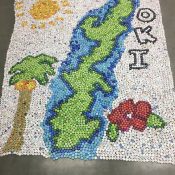
August 28, 2020 Ryukyu Shimpo
Sora Koki, 16, and Riara Kishimae, 16, are second-year students at Okinawa Shogaku High School and are the masterminds behind the Eco Cap Campaign, a school-wide project to collect and recycle plastic bottle caps. The campaign was tied to the United Nations Sustainable Development Goals (SDGs), specifically SDG 3: good health and the wellbeing of all, and SDG 12: responsible consumption and production. The campaign collected approximately 40,000 bottle caps between June 8 and July 6.
Koki and Kishimae have lived in Okisho’s school dorms since April 2019. The pair love volunteering and wanted to help others, and thus devised the Eco Cap Campaign. They teamed with the late Vice-Chairman Masaichiro Nashiro to involve the entire school to raise awareness of the UN SDGs and of the campaign itself.
Koki said cheerfully, “The two of us planned and executed the campaign, which helped build our independence.” Kishimae commented, “Coming to Okisho, I got to work on projects I was interested in. It’s been fun and I learned a lot.” She added, “high schoolers can contribute to SDGs too.”
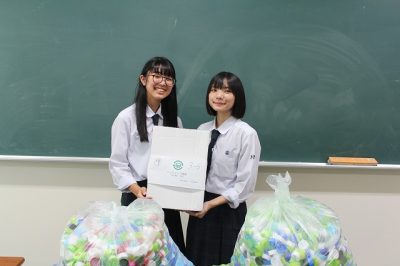
The masterminds behind the Eco Cap Campaign, Riara Kishimae (left) and Sora Koki, (right) pose for a photograph at Okisho High School in Kokuba, Naha City, on August 25.
The Eco Cap Campaign is designed to collect and recycle plastic bottle caps into new products. The proceeds from the sales of those goods will be used to pay for vaccinations and provide medical support in developing countries. Students, parents and guardians, as well as the staff of the Naha Sakura Mother and Child Livelihood Support Center, have participated in the campaign.
The accumulated plastic bottle caps will be collected by Okinawa Clean Kogyo for recycling around September.
(English translation by T&CT and Monica Shingaki)
Go to Japanese
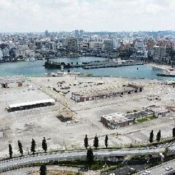
August 24, 2020 Ryukyu Shimpo
The Okinawa Prefectural Government and Naha and Urasoe municipal governments came to a de facto agreement on the relocation to Urasoe of the U.S. military’s Naha Port Facility (Naha Military Port), agreeing that the replacement facility will be built on the north side of the Urasoe wharf zone. Discussions are expected to accelerate now that contention regarding the positioning of the replacement facility, which was the biggest factor stalling the talks, has been resolved. The three parties aim to proceed with the relocation from the perspective of economic revitalization, but they face many challenges. There is criticism that the relocation merely moves the U.S. military facility to another part of Okinawa, just as in the case of the new base construction in Henoko, Nago. Amidst many twists and turns, the environment surrounding the relocation issue has also seen a drastic change. Below we will review the issues surrounding of the military port relocation issue.
There are undispellable concerns that the military functions of Naha Military Port will be intensified when it is relocated to Urasoe. All that has been decided as of yet is the general plan that a replacement facility for the military port will be built on the north side of the civilian port in Urasoe, with the details of the design and functions subject to future negotiations. There is no assurance that the base functions will be limited to their current scope. The water depth at the planned relocation site is deeper than at the present site, and it is highly likely that larger-scale ships will able to enter the new port.
At the present military port, the water is only about 10 meters deep, while the water off the Urasoe wharf zone at the relocation site is said to be 15-20 meters deep. This is equivalent to the depth at the new wharf zone at Naha Port, where many large ships come to port, and depending on negotiations following the relocation, it may become possible for large U.S. military vessels to enter the port.
The Okinawa Prefectural Government and Urasoe municipal government have confirmed with the Japanese government that the functions of and operations at the relocation site will not exceed those at the present military port in their acceptance of the relocation plan. However, since the design and functions are subject to future negotiations, it is not clear that the facility’s functions will be limited to their present level.
Concerning the return of U.S. Marine Corps Air Station (MCAS) Futenma, which is similarly conditioned on relocation within Okinawa, a condition leading to considerable resistance, it was discovered after the fact that the base functions would be intensified in the base construction for relocation to Henoko, Nago. People came to refer to the construction as construction of a “new base” as it became clear that the base being constructed will include functions not present at MCAS Futenma.
(English translation by T&CT and Sandi Aritza)
Go to Japanese

August 24, 2020 Ryukyu Shimpo
October 30 was designated World Uchinanchu Day in 2016 during the 6th Worldwide Uchinanchu Festival (Uchinanchu Taikai), falling on the final day of the multi-day event. One of the masterminds behind the celebratory day is Andres Higa, 46, a member of the Nago International Association. August 23, 2020, marked 30 years since the first Worldwide Uchinanchu Festival, which Higa explains “is a place where uchinanchus around the world come together as one.”
Higa is a third-generation Okinawan Argentinian with roots in Nago City. He first attended the 4th Uchinanchu Festival where Higa recalls, “people gathered from all over the world and I was able to experience my roots.”
He immigrated to Japan in 2008, attended Meio University and its graduate school before landing his current employment. At the time, Higa asked himself, “are there more opportunities to think about uchinanchus?” He then began working with Andres Tadashi Isa, a third-generation Okinawan Peruvian, and they created World Uchinanchu Day. They made a case for this special day in front of the Nago City Council, which then moved the prefectural government and public opinion.
The 7th Uchinanchu Festival is scheduled to take place next year, although there are concerns over whether it will go ahead due to the novel coronavirus pandemic. Still, Higa is hopeful: “It will be the first Uchinanchu Festival since the Shuri Castle burned down, which was the symbol of Okinawan identity. I hope the festival will help bring everyone together.”
(English translation by T&CT and Monica Shingaki)
Go to Japanese
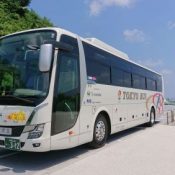
August 25, 2020 Ryukyu Shimpo
Tokyo Bus (headquarters: Tokyo; Harunari Nishimura, CEO) which operates tour buses and regular routes all over Japan, is opening up two transit bus routes in Okinawa. Starting September 14, they will be taking over a line from Chubu Kanko Service (based in Tomigusku) that connects Naha airport and Chura Sun Beach (Iias Okinawa Toyosaki) via Senaga Island, and will be launching a new route at the start of October that runs from Itoman City Hall to Palette Kumoji in Naha. On August 19 they obtained the license to operate bus lines from the Okinawa General Bureau.
Tokyo Bus opened their Okinawa sales office in Tomigusuku in January of this year, and started chartering buses for sightseeing around Okinawa. Meanwhile, they were making preparations to open routes anticipated to see high demand from tourists.
As part of their business plan, the company procured 22 buses for chartering, and they increased their fleet with an additional 9 buses for the start of their regular transit routes. They also hired 21 employees, including drivers, in Okinawa. A company representative running the sales office in Okinawa said, “Since the plan was developed prior to the coronavirus pandemic, currently we are in a bit of a tough situation, however we are taking a long-term view in expecting the southern region to develop.”
The route from Naha Airport to Chura Sun Beach has been operated by Chubu Kanko Service since 2019, however they will cease operating the route September 13. There was a decrease in passengers due to COVID-19, and it became difficult to maintain the regular route. Hereafter Chubu Kano Service will focus solely on sightseeing busing, and eight of their drivers were hired by Tokyo Bus.
Tokyo Bus runs routes such as highway bus routes from Tokyo to the Kansai region, limousine buses to Narita airport, and also has developed a charter and sightseeing bus business. They also own a number of affiliated companies in Hokkaido and the Kansai region.
Chubu Kanko Service changed from a limited liability company to a publicly traded company in 2018 when they became a subsidiary of WBF Holdings (Osaka), and started operating transit routes. However, sales slumped due to COVID-19, and this year WBF divested their shares of the company.
(English translation by T&CT and Sam Grieb)
Photograph: Tokyo Bus driving in Okinawa (photograph provided by the company)
Go to Japanese
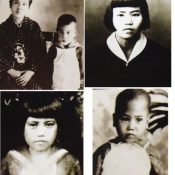
August 21, 2020 Ryukyu Shimpo
By Reiko Akamine
Aug 22, 2020 marks 76 years to the day since Tsushima Maru, a passenger/cargo ship carrying children and civilian evacuees out of Okinawa, was sunk by an American submarine during WWII. While the number of living survivors and bereaved families has shrunk over the years, a diary offering insights into the sentiments of a grieving husband was made available to the public for the first time. The Battle of Okinawa in Nanjo-shi: The Archives was published by the Nanjo City Board of Education in March this year, and includes excerpts from a diary kept by Motohide Tonaki, who was the mayor of Sashiki Village after the war (Tonaki passed away in 1972.) Tonaki lost his wife and four children in the sinking of Tsushima Maru and wrote in one entry: “I made the greatest irreparable mistake of my lifetime.”
Nanjo-shi’s historical records specialist, Yuki Yamauchi, was an editor for The Battle of Okinawa in Nanjo-shi: The Archives. Yamauchi commented, “The diary is an invaluable document, as the entries were written in real-time. It tells us what the bereaved families were feeling about the incident at the time.” Tonaki’s diary begins in March 1944, and ends on May 2, 1945, during the Battle of Okinawa. The publication only contains experts from his diary pertaining to the Tsushima Maru incident.
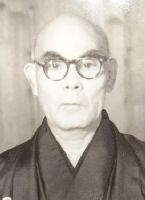
Motohide Tonaki
Tonaki first mentions the Tsushima Maru in a journal entry made on July 20, 1944. It was after the annihilation of the Japanese Army in Saipan, and the U.S. troops’ landing on Okinawa was imminent. The national and prefectural governments began evacuating the women, children, and the elderly out of Okinawa. Tonaki, who was a prefectural government employee at the time, obligingly evacuated his wife and children.
In an Aug 19 entry, Tonaki wrote that he obtained the transfer documents and certificates required to evacuate his wife and children. Next to the main entry, the words “mistake of a lifetime” are jotted down. It appears Tonaki added the remorseful note later when he learned of the unfortunate fate of the ship.
The Tsushima Maru departed on Aug 21, with Tonaki’s wife and four children on board. Tonaki’s journal entry on Aug 22 provides a glimpse into the loneliness he felt after sending off his family: “The house is quiet as if a fire has gone out.” The Tsushima Maru was sunk that night.
Tonaki appears to have heard the rumor on Aug 25 or 26 that the Tsushima Maru was shipwrecked. In September he noted: “seems to be few casualties,” then “159 dead,” and “confidential information,” evidencing the mix of information he received. The diary indicates he attempted to gather information about his family. When Tonaki finally learned that his wife and four children were not among the survivors, he wrote the word “despair” in his journal. Later, he documented how he organized their belongings and how often his friends and family visited. Tonaki also detailed how he went to the docks to welcome back the spirits of his family from the sea, as their remains were not recovered. Tonaki’s diary provides valuable insights into his life following the Tsushima Maru incident.
Akiko Yamashiro, a Nanjo-shi historical records specialist commented, “Official documents rarely provide insights into how people thought and spent their days. We can see from Tonaki’s diary that the bereaved tried to carry on with their wounds. It’s a historical record that enables us to feel their lives and emotions.”
According to the specialists of Nanjo-shi’s historical records, the former Sashiki City records department created a transcript of Tonaki’s journal and held the records in safekeeping. However, the whereabouts of Tonaki’s original diary is currently unknown.
(English translation by T&CT and Monica Shingaki)
Go to japanese
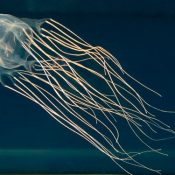
August 21, 2020 Ryukyu Shimpo
Uruma – Between August 1 and 19, 11 people were rushed to the hospital after being stung by box jellyfish or Portuguese man o’ wars, leading the Uruma Fire Department (led by Fire Chief Asahiro Morimizato) to call for increased caution. “We are asking people to cover up any bare skin and to use beaches where nets have been set up to keep out the box jellyfish.”
Among the individuals taken to the hospital, 9 were stung by box jellyfish and 2 were stung by Portuguese man o’ wars. Most of the incidents occurred near the shoreline of the Kaichu Road in Uruma, the shore of Hamahiga on Hamahiga Island, and the shore at Higa Fishing Port.
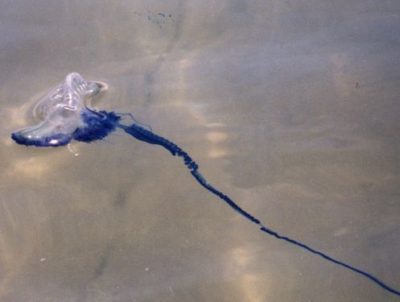
Portuguese man o’ war (photograph provided by the Okinawa Institute of Health and Environment)
To prevent the spread of the novel coronavirus, beaches with jellyfish protections are closed. This may be causing increasing numbers of people to swim at other beaches. The head of the Okinawa Department of Public Health and Medical Care says, “please check with municipal or hotel beach managers if nets have been set up and if the beaches are closed before you swim. Also, we ask that you refrain from swimming.”
The highly venomous box jellyfish grows to a size at which they are able to hurt humans between June and September. There have been fatal stings in the past. A box jellyfish warning has been announced by the prefecture (effective until September 30). The Portuguese man o’ war is a venomous pelagic jellyfish that can be carried into shore on very windy days.
According to prefecture representatives, there were 166 injuries from dangerous marine life in Okinawa Prefecture last year. Thirty-seven of those (approximately 22%) involved box jellyfish.
(English translation by T&CT and Ellen Huntley)
Go to Japanese














 Webcam(Kokusai Street)
Webcam(Kokusai Street)


